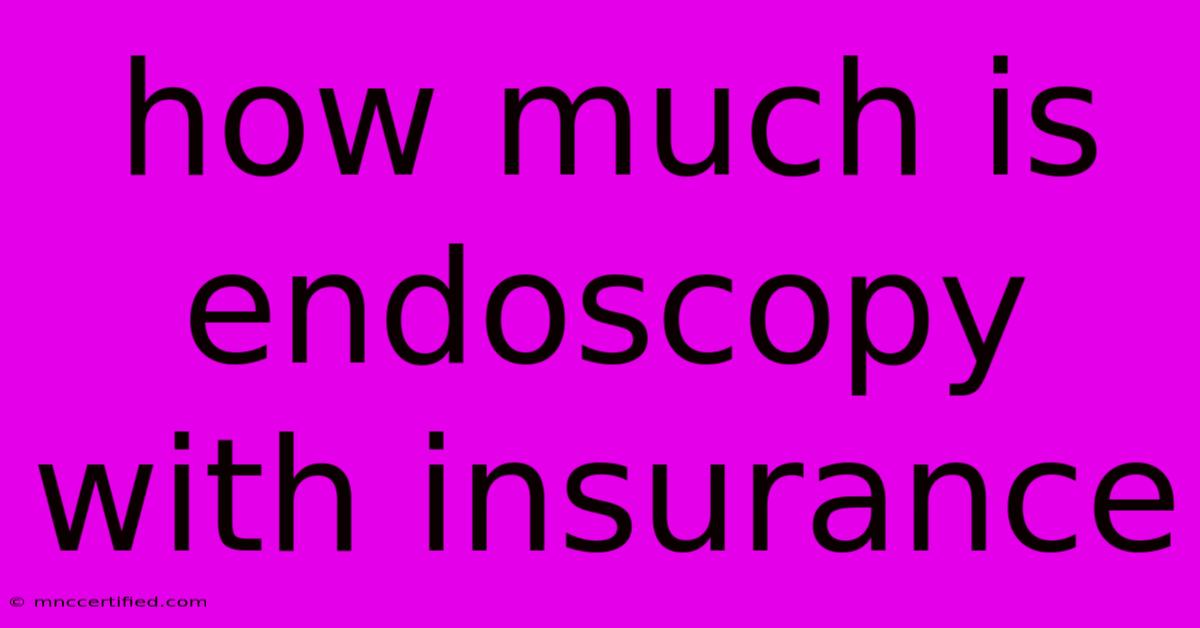How Much Is Endoscopy With Insurance

Table of Contents
How Much Does an Endoscopy Cost With Insurance? A Comprehensive Guide
An endoscopy is a common medical procedure used to visualize the inside of your digestive tract. It can help diagnose a variety of conditions, from ulcers and Crohn's disease to cancer. While the cost of an endoscopy can vary significantly, understanding how insurance plays a role can help you budget and plan for this procedure.
Factors Affecting Endoscopy Costs with Insurance
The final cost of an endoscopy with insurance will depend on several factors, including:
- Your insurance plan: Different insurance plans have different coverage levels and copays for endoscopies. Some plans may require you to meet a deductible before they start covering the procedure.
- The type of endoscopy: Different types of endoscopies, such as upper endoscopy, colonoscopy, and esophageal endoscopy, have varying costs.
- Location of the procedure: The cost of an endoscopy can vary depending on the location of the clinic or hospital where the procedure is performed.
- Complexity of the procedure: If the procedure is complex, such as requiring biopsies or polyp removal, the cost will be higher.
- Anesthesia: The type of anesthesia used during the procedure will also impact the cost.
Understanding Your Insurance Coverage
To determine your out-of-pocket cost, it's crucial to understand your insurance policy and benefits. Here's a breakdown of key things to look for:
- Copay: This is a fixed amount you pay for each service, such as an endoscopy.
- Deductible: This is the amount you need to pay out-of-pocket before your insurance begins covering the procedure.
- Coinsurance: This is a percentage of the cost you are responsible for after meeting your deductible.
- Out-of-pocket maximum: This is the maximum amount you'll pay out-of-pocket for healthcare costs in a year.
Contact Your Insurance Provider
The best way to determine your exact cost is to contact your insurance provider directly. They can provide you with a pre-authorization or pre-determination of benefits for the specific procedure you need. This will tell you:
- How much your insurance will cover.
- What your out-of-pocket costs will be.
- Whether the procedure is covered under your plan.
Negotiating Costs and Payment Options
Negotiation: While less common for medical procedures, it's worth discussing with your healthcare provider if you are facing significant out-of-pocket expenses. Some practices may offer payment plans or discounts.
Payment Options: Many hospitals and clinics offer financing options, such as monthly payment plans or healthcare credit cards, to help manage costs. Be sure to research the terms and conditions of these options to understand interest rates and fees.
Conclusion
Knowing the factors that influence the cost of an endoscopy with insurance can help you plan and budget for the procedure. Understanding your insurance benefits and contacting your insurance provider for a pre-authorization can provide clarity on your out-of-pocket expenses. By understanding your options and actively communicating with your healthcare provider, you can navigate the financial aspects of this important procedure.

Thank you for visiting our website wich cover about How Much Is Endoscopy With Insurance. We hope the information provided has been useful to you. Feel free to contact us if you have any questions or need further assistance. See you next time and dont miss to bookmark.
Featured Posts
-
Arsenal Vs Chelsea Preview Key Battles
Nov 11, 2024
-
Live Rugby Wales Triumphs Over Fiji
Nov 11, 2024
-
Veterans Day 2024 Deals Food Discounts And More
Nov 11, 2024
-
Chiefs Defense Steps Up Blocks Field Goal For Win
Nov 11, 2024
-
Bernard Hill Tributes Pour In After Death
Nov 11, 2024